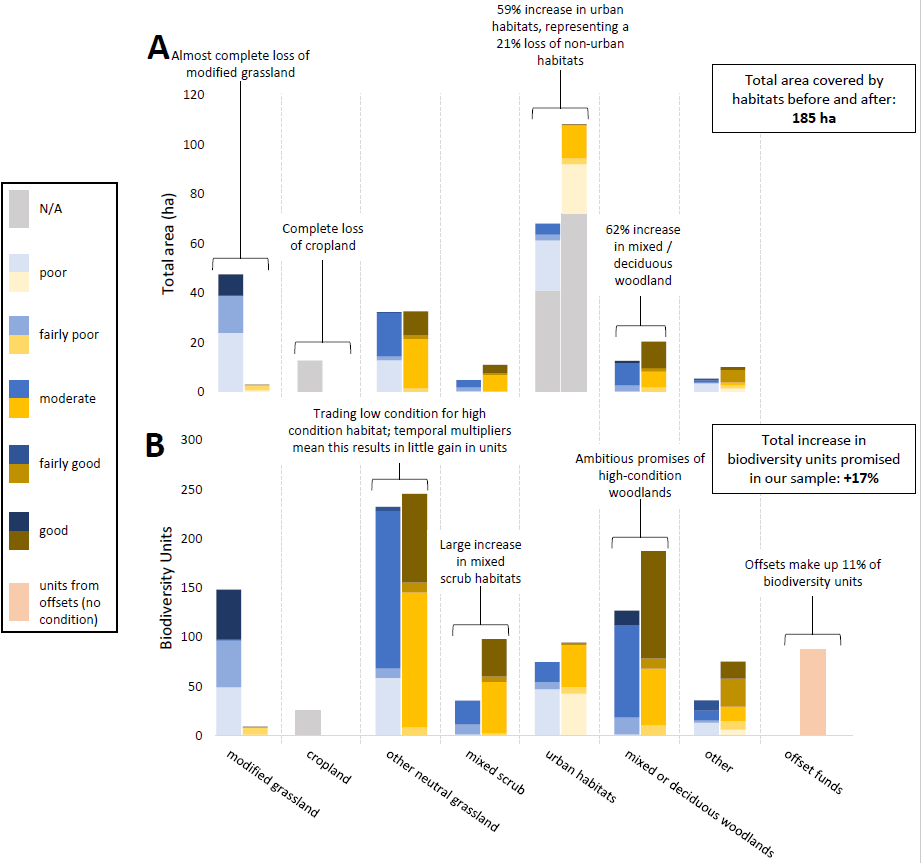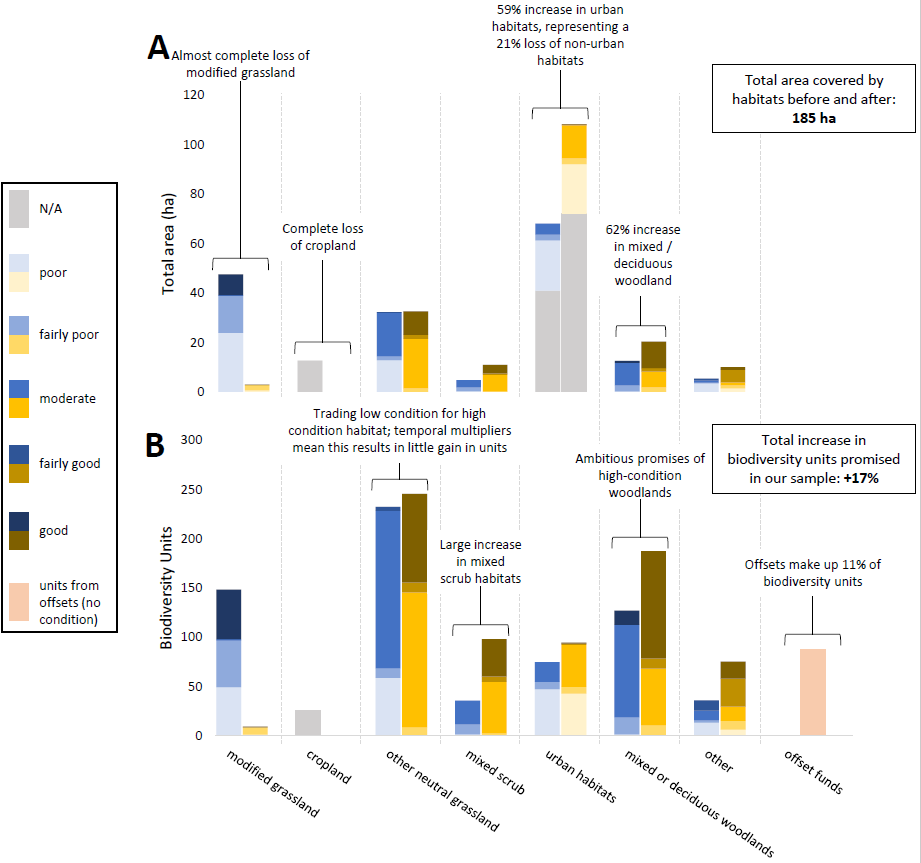In 2023, England is going to introduce the world's most wide-ranging No Net Loss/Net Gain-type policy, mandatory Biodiversity Net Gain (BNG). We collected data from early-adopter councils to ask: what are its impacts likely to be? Preprint here: https://osf.io/preprints/socarxiv/tw6nr/ thread /1
The Environment Bill, soon to be ratified, says that every new-build regulated under the Town & Country Planning Act will have to demonstrate it leaves biodiversity better off than before, using the 'Biodiversity Metric', a simple composite indicator (described in paper) /2
In concept, the policy is hugely ambitious, representing the first time biodiversity loss will be fully integrated into land-use economics and decision-making for most new development across an entire country (but note 'Nationally Significant Infrastructure' is still exempt) /3
There's high hopes for BNG. Different docs show hopes it will improve access to greenspace in urban areas; reverse UK wildlife declines; help build a market for for-profit biodiversity units; raise investment for the Local Nature Recovery Networks; 'streamline' development /4
To investigate empirically, our team of academics ( @wildbusiness @DICE_Kent) planners & consultants worked with 4 councils who have adopted BNG-type policies early, & collected all the BNG assessments for new infrastructure projects for Jan-Nov 2020. /5
Our sample spans ~1% of UK annual housebuilding, & various other infra projects. We found 44 projects mentioning BNG assessments, 29 contained data. Then, we simply aggregated all BNG assessments to see what the impact of BNG-type policies is on habitats across our sample. /6
Here's we we found. Key results: BNG-type policies are associated with a 21% loss in non-urban habitat area in our sample. But they promise a 17% increase in biodiversity units, because developers are promising higher condition (but smaller) habitats in the future. /7
The market for off-site biodiversity units in our sample is small (11% of units), because developers are promising to deliver the vast majority of units on land they own either within the development footprint, or directly adjacent offsets. /8
To give a sense of what kinds of habitats are being delivered within development footprints that still contribute towards the policy's overall biodiversity outcomes: 11% of units in our sample come from grasslands and scrubland within housing developments /9
So, given developers are promising smaller, but higher quality habitats in the future, it is essential that a) the way that 'quality' is measured is robust; b) the governance is in place to ensure these promises materialise in reality. We investigated further. /10
First, we did a survey with a small sample of very specialised grassland experts, to see if, given the information provided in the grassland descriptions, they would come to the same conclusion regarding the grassland type & condition as the BNG assessments did /11
The experts agreed with the habitat type designation given in the BNG report 42% of the time, condition 64%, and both 31% of the time. This is evidence the habitat designation (which goes on to affect how many units a habitat 'generates') is open to judgement-based variation /12
Next, we reviewed all the documentation around the policy to investigate references to governance, to see if things are in place (carrots & sticks) to ensure that promised biodiversity gains (remember, mostly condition gains of on-site habitats) will be delivered in reality /13
In sum: commitments to deliver 'off-site' gains through the biodiversity units market are impressive. Government is promising a unit register, 1.3 ecologists for every higher-tier local authority in Eng, & 60 new staff for Natural England & Defra to manage & implement policy /14
However the gov't is not formally promising new measures for monitoring & enforcing the gains delivered on-site (remember, the vast majority of units). They claim local authority planning enforcement mechanisms are sufficient to police and guarantee these units are delivered /15
The problem: LPAs are explicitly advised not to take enforcement action unless it is a ‘serious harm to a local public amenity’. Unlikely that failure of a habitat to reach a certain condition level will fall under this: this means most gains under BNG may be unenforceable /16
Our work has been covered by @BESPolicy here ( https://www.britishecologicalsociety.org/mandatory-biodiversity-net-gain-may-not-deliver-the-desired-outcomes-for-nature/) & @WCL_News here ( https://www.wcl.org.uk/will-biodiversity-net-gain-improve-english-biodiversity-results-from-the-first-evaluation-of-net-gain,-and-whats-next.asp) /17
We still have a couple of years before mandatory BNG comes into force, so we have time to address unintended outcomes and risks. Lots of work to do! /end
Potentially of interest @GreenAllianceUK @CIEEMnet @Natures_Voice @NEF @_BTO @WildlifeTrusts @ShaunSpiers1 @CIWEMpolicy @iemanet @TonyJuniper @BESPolicy

 Read on Twitter
Read on Twitter



